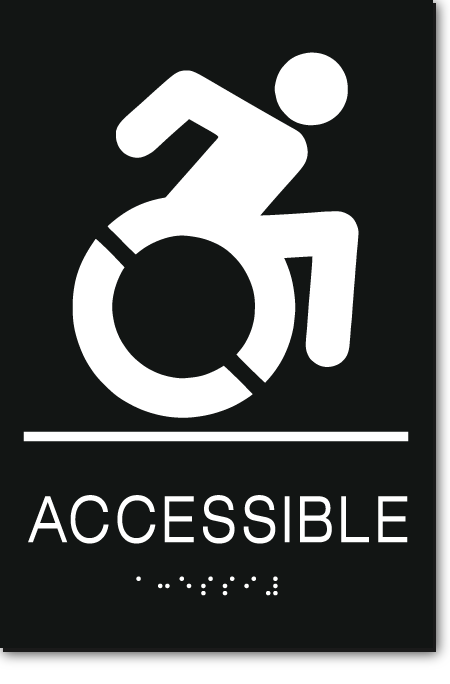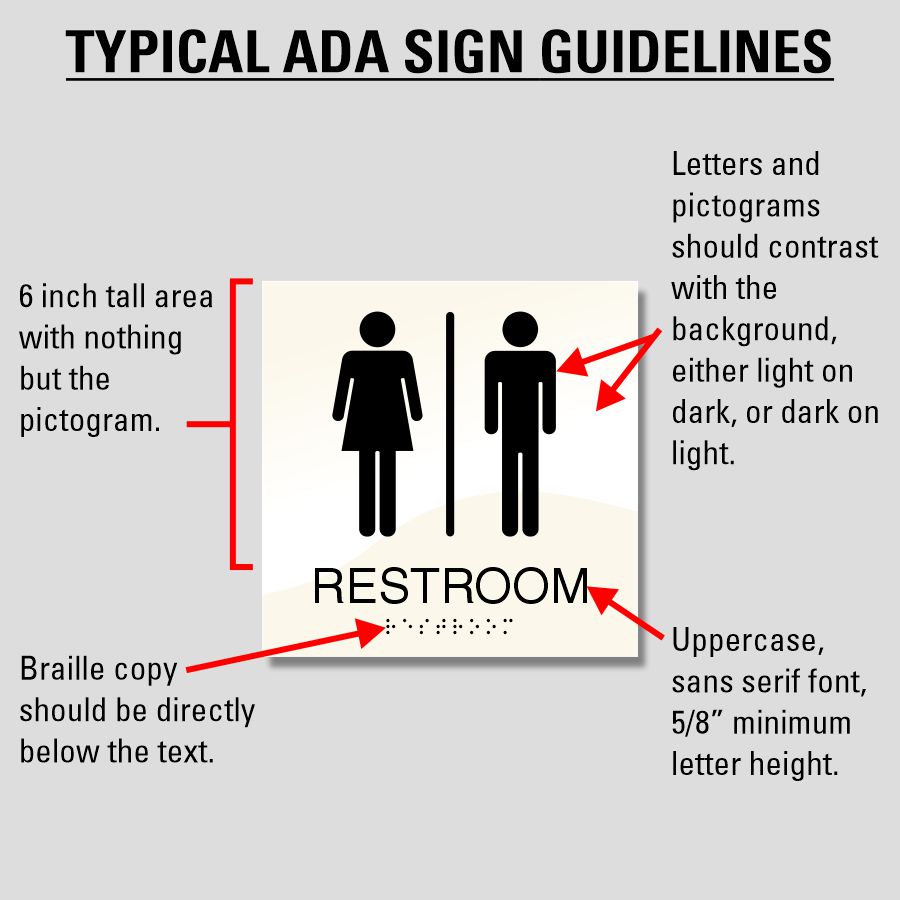Discovering the Trick Attributes of ADA Signs for Enhanced Accessibility
In the realm of accessibility, ADA indicators act as silent yet powerful allies, ensuring that rooms are accessible and comprehensive for individuals with handicaps. By incorporating Braille and tactile elements, these indicators damage barriers for the visually damaged, while high-contrast color pattern and legible typefaces accommodate diverse aesthetic requirements. Their strategic positioning is not arbitrary yet instead a calculated effort to promote seamless navigating. Yet, beyond these features exists a much deeper narrative about the advancement of inclusivity and the ongoing commitment to producing equitable spaces. What a lot more could these signs symbolize in our pursuit of global ease of access?
Importance of ADA Compliance
Guaranteeing conformity with the Americans with Disabilities Act (ADA) is essential for fostering inclusivity and equivalent access in public rooms and offices. The ADA, established in 1990, mandates that all public centers, companies, and transport solutions suit people with disabilities, guaranteeing they enjoy the same legal rights and possibilities as others. Conformity with ADA criteria not only satisfies lawful responsibilities however additionally boosts a company's credibility by showing its dedication to variety and inclusivity.
Among the vital aspects of ADA compliance is the implementation of easily accessible signs. ADA indicators are made to make certain that people with disabilities can easily navigate through structures and areas. These signs should follow particular guidelines concerning size, typeface, shade comparison, and placement to ensure exposure and readability for all. Appropriately carried out ADA signage helps eliminate obstacles that individuals with specials needs commonly come across, thus promoting their independence and self-confidence (ADA Signs).
In addition, sticking to ADA guidelines can reduce the danger of legal repercussions and potential penalties. Organizations that fail to adhere to ADA standards may deal with suits or penalties, which can be both damaging and monetarily burdensome to their public photo. Thus, ADA conformity is integral to promoting an equitable atmosphere for every person.
Braille and Tactile Elements
The incorporation of Braille and tactile elements into ADA signage symbolizes the concepts of accessibility and inclusivity. It is normally positioned under the corresponding text on signage to guarantee that individuals can access the info without visual help.
Tactile elements expand beyond Braille and consist of increased characters and icons. These parts are made to be noticeable by touch, enabling individuals to identify area numbers, toilets, exits, and various other essential locations. The ADA establishes particular guidelines regarding the dimension, spacing, and placement of these tactile components to optimize readability and guarantee consistency throughout different environments.

High-Contrast Color Pattern
High-contrast color design play a crucial function in enhancing the exposure and readability of ADA signage for people with visual disabilities. These schemes are crucial as they maximize the distinction in light reflectance between message and history, making sure that signs are quickly discernible, also from a distance. The Americans with Disabilities Act (ADA) mandates using certain shade contrasts to accommodate those with limited vision, making it a crucial element of conformity.
The effectiveness of high-contrast colors hinges on their ability to stick out in various illumination problems, including dimly lit settings and locations with glare. Normally, dark text on a light background or light message on a dark history is employed to accomplish optimum comparison. For instance, black text on a yellow or white background offers a plain aesthetic distinction that helps in fast recognition and comprehension.

Legible Fonts and Text Dimension
When taking into consideration the layout of ADA signs, the option of clear fonts and appropriate message dimension can not be overstated. The Americans with Disabilities Act (ADA) mandates that fonts must be not italic and sans-serif, oblique, manuscript, highly decorative, or of unusual type.
According to ADA guidelines, the minimal text elevation ought to be 5/8 inch, and it needs to boost proportionally with viewing range. Consistency in text dimension contributes to a natural visual experience, assisting individuals in browsing environments effectively.
Additionally, spacing in between letters and lines is indispensable to clarity. Adequate spacing stops characters from showing up crowded, enhancing readability. By sticking to these criteria, designers can dramatically boost access, making certain that signage serves its desired objective for all people, regardless of their aesthetic capacities.
Efficient Positioning Techniques
Strategic placement of ADA signage is essential for making the most of ease of access and ensuring compliance with legal requirements. ADA standards stipulate that signs must be mounted at an elevation in between 48 to 60 inches from the ground to guarantee they are within the line of sight for both standing and seated individuals.
In addition, indications need to be placed nearby to the lock side of doors to permit very easy identification before access. Uniformity in indicator placement throughout a facility improves predictability, reducing complication and improving general user experience.

Final Thought
ADA signs play a vital duty in advertising accessibility by integrating features that resolve the requirements of individuals with specials needs. Integrating Braille and tactile components makes sure crucial details is available to the visually impaired, while high-contrast color pattern and legible sans-serif typefaces improve visibility across various lighting conditions. Reliable positioning approaches, such as suitable installing heights and calculated places, further assist in navigating. These aspects jointly foster an inclusive setting, highlighting the importance of ADA compliance in making sure equivalent accessibility for all.
In the realm of access, ADA indications offer as quiet yet powerful allies, guaranteeing that spaces are inclusive and accessible for individuals with impairments. The ADA, enacted in 1990, mandates that all public facilities, companies, and transportation services accommodate people with specials needs, ensuring they enjoy the very same legal rights and opportunities as others. ADA Signs. ADA indicators are created to guarantee that individuals with specials needs can quickly browse with buildings and rooms. ADA guidelines specify that indications should be installed at a height in between 48 to 60 inches from the ground to ensure they are within the line of view for both standing and seated individuals.ADA indications play a vital function in promoting availability by integrating functions that deal with the demands of people with disabilities